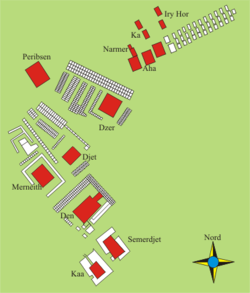| Merneith | ||||||
|---|---|---|---|---|---|---|
 Tomb stela of Merneith from the Umm el-Qa'ab | ||||||
| Reign | c. 2965 BC [1] | |||||
| Predecessor | Djet | |||||
| Successor | Den | |||||
| ||||||
| Consort | Djet | |||||
| Children | Den | |||||
| Died | c. 2950 BC | |||||
| Burial | Tomb Y, Umm El Qa'ab, Sohag, Egypt | |||||
| Dynasty | 1st Dynasty | |||||
Merneith (also written Merit-neith and Meryt-Neith; died c. 2950 BC) was a consort and a regent of Ancient Egypt during the First Dynasty. [2]
Contents
She may have been a ruler of Egypt in her own right, based on several official records. [3] [4] If this was the case and the earlier royal wife Neithhotep never ruled as an independent regent, Merneith may have been the first female pharaoh and the earliest queen regnant in recorded history. Her rule occurred around 2950 BC [1] for an undetermined period. Merneith's name means "Beloved by Neith" and her stele contains symbols of that ancient Egyptian deity. She may have been Djer's daughter and was probably Djet's senior royal wife. [5] The former meant that she would have been the great-granddaughter of unified Egypt's first pharaoh, Narmer. She was also the mother of Den, [6] her successor. [7]


